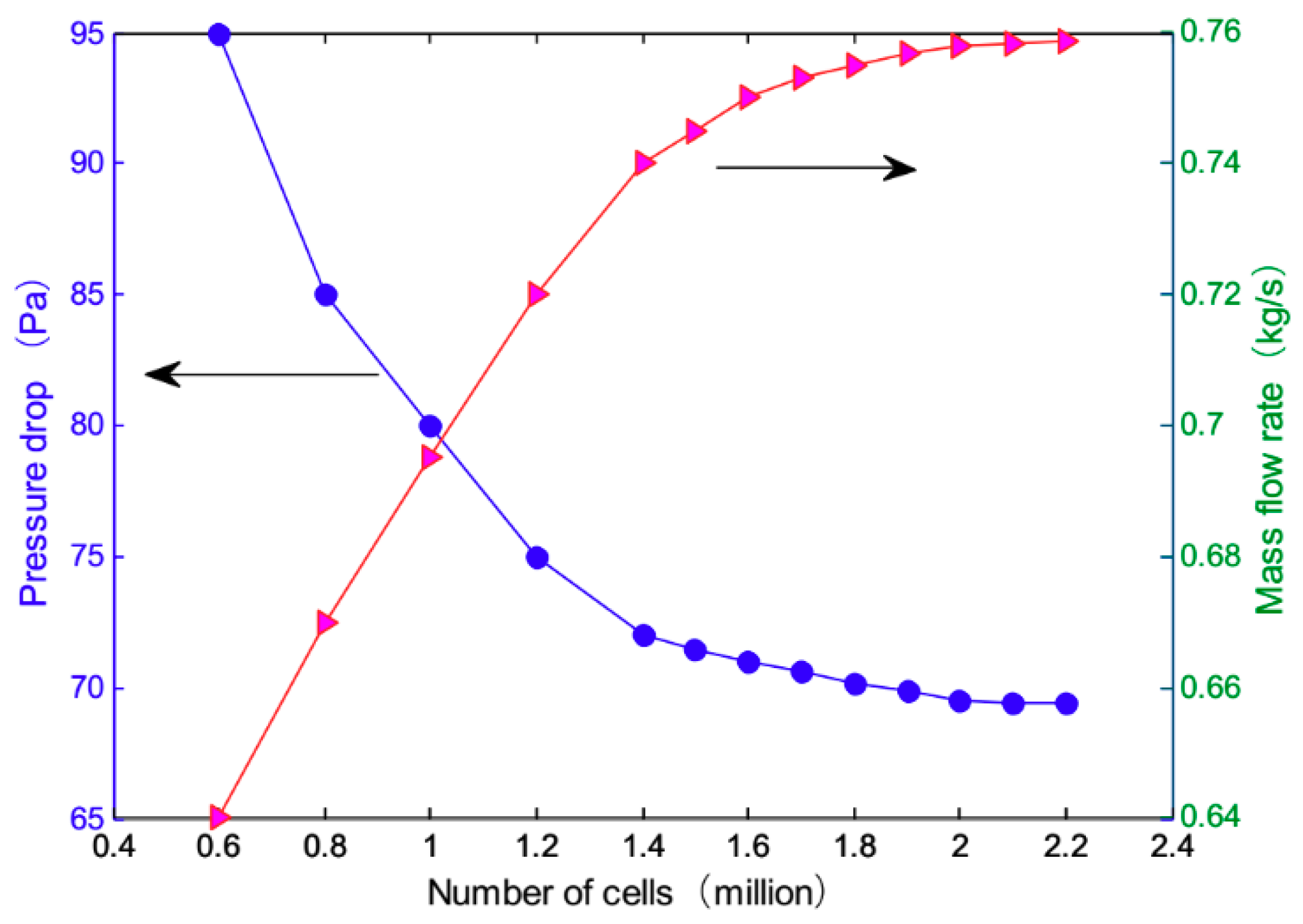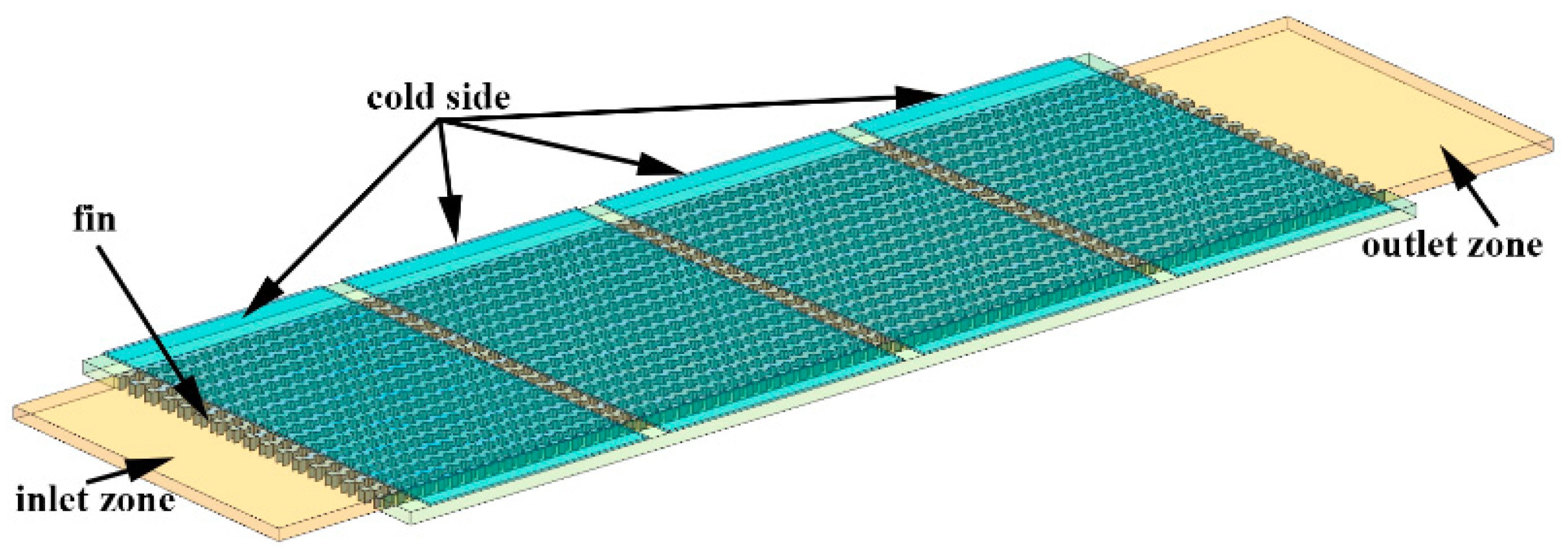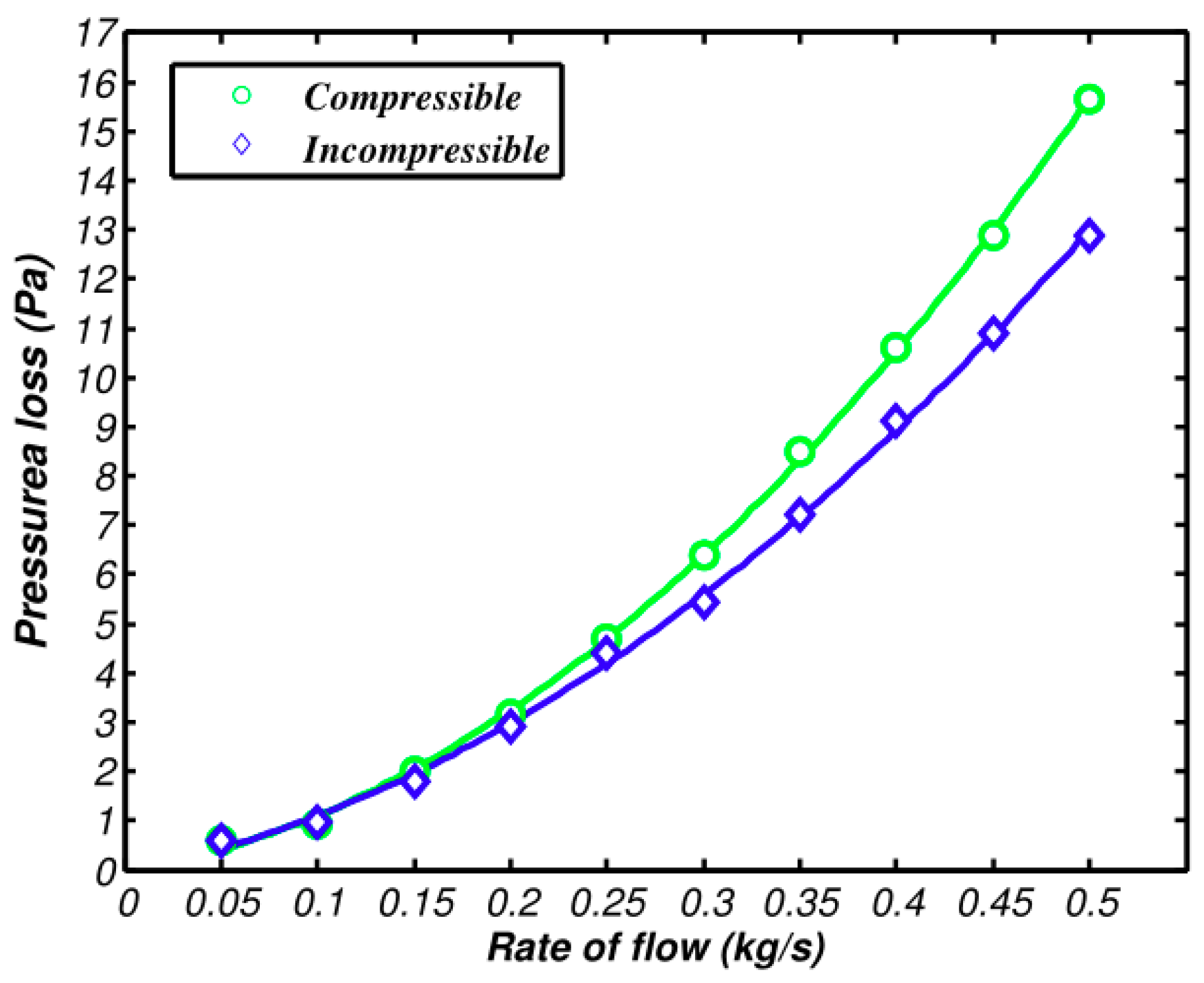The Effect of Compressible Flow on Heat Transfer Performance of Heat Exchanger by Computational Fluid Dynamics (CFD) Simulation
Abstract
:1. Introduction
2. Compressible and Incompressible Flow Model for Heat Exchanger
3. Simulation Model and Boundary Conditions
3.1. Simulation Model
3.2. Boundary Conditions
4. Results and Discussion
4.1. Analysis of the Simulation Result
4.2. Analysis on Experimental Comparison
5. Conclusion
- (1)
- Based on wall friction, heat exchange and variation of runner cross section, the compressible flow model of a heat exchanger is established. Compared with traditional solving methods based on incompressibility, the matching precision of the compressible flow model with the experimental value is higher. The largest deviation of heat exchange value and experimental value is 6.5%, the largest deviation of pressure loss is 7.5%, which guides for the optimization of the design of the heat exchanger.
- (2)
- When the flow velocity is low, both compressible and incompressible models can meet the requirements. But at high flow velocity, the accuracy of the compressible model is noticeably higher than that of the incompressible model.
- (3)
- In order to meet the demand of the engine for air intake, the compressible model can be used to predict the performance of the new structure of the intercooler more accurately. It also saves time and development costs.
- (4)
- In order to predict the performance of the intercooler more accurately, the simulation model should be further studied under multi-field coupling, in the future. A full size simulation of an intercooler will also need be carried out.
Author Contributions
Funding
Conflicts of Interest
References
- Yaïci, W.; Ghorab, M.; Entchev, E. 3D CFD analysis of the effect of inlet air flow maldistribution on the fluid flow and heat transfer performances of plate-fin-and-tube laminar heat exchangers. Int. J. Heat Mass Transfer 2014, 74, 490–500. [Google Scholar] [CrossRef]
- Mezher, H.; Chalet, D.; Raimbault, V.; Migaud, J. Wave dynamics analysis at the intake of a turbocharged engine: Concept proposal of a new active inlet charge air duct for low-speed tuning and high-speed permeability. Proc. Inst. Mech. Eng. Part D. 2015, 230, 160–174. [Google Scholar] [CrossRef]
- Seo, J.-W.; Cho, C.; Lee, S.; Choi, Y.-D. Thermal Characteristics of a Primary Surface Heat Exchanger with Corrugated Channels. Entropy 2015, 18, 15. [Google Scholar] [CrossRef]
- Nagarajan, V.; Chen, Y.; Wang, Q.; Ma, T. CFD modeling and simulation of sulfur trioxide decomposition in ceramic plate-fin high temperature heat exchanger and decomposer. Int. J. Heat Mass Transfer 2015, 80, 329–343. [Google Scholar] [CrossRef]
- Taler, D.; Ocłoń, P. Determination of heat transfer formulas for gas flow in fin-and-tube heat exchanger with oval tubes using CFD simulations. Chem. Eng. Process. 2014, 83, 1–11. [Google Scholar] [CrossRef]
- Bala Sundar Rao, R.; Ranganath, G.; Ranganayakulu, C. Development of Colburn j Factor and Fanning Friction Factor Correlations for Compact Surfaces of the Triangular Perforated Fins Using CFD. Heat Transfer Eng. 2015, 37, 150–161. [Google Scholar] [CrossRef]
- Chen, H.-T.; Lin, Y.-S.; Chen, P.-C.; Chang, J.-R. Numerical and experimental study of natural convection heat transfer characteristics for vertical plate fin and tube heat exchangers with various tube diameters. Int. J. Heat Mass Transfer 2016, 100, 320–331. [Google Scholar] [CrossRef]
- Momeni, S.M.; Salehi, G.; Nimvari, M.E. Modeling and thermoeconomic optimization of marine diesel charge air cooler. Energy 2018, 162, 753–763. [Google Scholar] [CrossRef]
- Marty, P.; Hétet, J.-F.; Chalet, D.; Corrignan, P. Exergy Analysis of Complex Ship Energy Systems. Entropy 2016, 18, 127. [Google Scholar] [CrossRef]
- Pal, A.; Manish, V.; Gupta, S.; Kumar, N. Performance and Emission Characteristics of Isobutanol-Diesel Blend in Water Cooled CI Engine Employing EGR with EGR Intercooler. SAE Tech. Pap. Ser. 2013, 24, 0151. [Google Scholar]
- Holland, B.G.; McKinley, T.L.; Storkman, B.R. Modeling Approach to Estimate EGR Cooler Thermal Fatigue Life. SAE Int. J. Engines. 2015, 8, 1724–1732. [Google Scholar] [CrossRef]
- Garcia, J.J. Exhaust Gas Condensate Corrosion Test on Low Pressure Cooling System of Aluminum Brazed EGR, ACAC and WCAC. SAE Tech. Pap. Ser. 2012, 1, 1947. [Google Scholar]
- Hoseini, S.S.; Najafi, G.; Ghobadian, B.; Yusaf, T.; Mamat, R. Experimental and numerical analysis of flow and heat transfer characteristics of EGR cooler in diesel engine. Appl. Therm. Eng. 2018, 140, 745–758. [Google Scholar] [CrossRef]
- Hadjab, R.; Kadja, M. Computational fluid dynamics simulation of heat transfer performance of exhaust gas re-circulation coolers for heavy-duty diesel engines. J. Therm. Sci. 2018, 22, 2733–2745. [Google Scholar] [CrossRef]
- Mezher, H.; Migaud, J.; Raimbault, V.; Lelong, J.G.; Chalet, D.; Perrot, N.; Alexandre, H.; Pascal, C.; Bernhard, H. Optimized Air Intake for a Turbocharged Engine Taking into Account Water-Cooled Charge Air Cooler Reflective Properties for Acoustic Tuning. SAE Tech. Pap. Ser. 2013, 1, 0575. [Google Scholar]
- Salmon, P.; Könözsy, L.; Temple, C.; Grove, S. Numerical investigation on various heat exchanger performances to determine an optimum configuration for charge air cooler, oil and water radiators in F1 sidepods. Appl. Therm. Eng. 2017, 117, 235–244. [Google Scholar] [CrossRef]
- Zhao, X.; Grönstedt, T. Conceptual design of a two-pass cross-flow aeroengine intercooler. Proc. Inst. Mech. Eng. Part G. 2014, 229, 2006–2023. [Google Scholar] [CrossRef]
- Zegenhagen, M.T.; Ziegler, F. Feasibility analysis of an exhaust gas waste heat driven jet-ejector cooling system for charge air cooling of turbocharged gasoline engines. Appl. Energy. 2015, 160, 221–230. [Google Scholar] [CrossRef]
- Dong, J.Q.; Su, L.; Chen, Q.; Xu, W.W. Experimental study on thermal–hydraulic performance of a wavy fin-and-flat tube aluminum heat exchanger. Appl. Therm. Eng. 2013, 51, 32–39. [Google Scholar] [CrossRef]
- Chen, Y.P.; Sheng, Y.J.; Dong, C.; Wu, J.F. Numerical simulation on flow field in circumferential overlap trisection helical baffle heat exchanger. Appl. Therm. Eng. 2013, 50, 1035–1043. [Google Scholar] [CrossRef]
- Liu, J.J.; Liu, Z.C.; Liu, W. 3D numerical study on shell side heat transfer and flow characteristics of rod-baffle heat exchangers with spirally corrugated tubes. Int. J. Therm. Sci. 2014, 89, 34–42. [Google Scholar] [CrossRef]
- Kays, W.M.; London, A.L. Compacted Heat Exchangers; McGraw-Hill: New York, NY, USA, 1984. [Google Scholar]
- Yu, C.; Qin, S.C.; Liu, Y.; Chai, B.S. Heat exchange performance optimization of a wheel loader cooling system based on computational fluid dynamic simulation. Adv. Mech. Eng. 2018, 10. [Google Scholar] [CrossRef] [Green Version]











| Density (kg/m3) | Specific Heat Capacity (kJ/kg·K) | Thermal Conductivity (W/m·k) | Dynamic Viscosity (Pa·s) |
|---|---|---|---|
| 2.656 | 1.015 | 3.25 × 10−2 | 22.83× 10−6 |
| Flow Rate/(kg·s−1) | Heat Exchange Deviation/% | Pressure Loss Deviation/% | ||
|---|---|---|---|---|
| Compressible | Incompressible | Compressible | Incompressible | |
| 0.1 | 0.1 | −0.1 | 3.4 | 5.2 |
| 0.2 | 0.7 | −8.3 | −3.2 | 5.0 |
| 0.3 | −7.2 | −14.3 | −2.9 | 14.0 |
| 0.4 | −4.2 | −4.4 | 4.6 | 21.8 |
| 0.5 | −6.5 | −13 | 7.5 | 30.5 |
© 2019 by the authors. Licensee MDPI, Basel, Switzerland. This article is an open access article distributed under the terms and conditions of the Creative Commons Attribution (CC BY) license (http://creativecommons.org/licenses/by/4.0/).
Share and Cite
Yu, C.; Qin, S.; Chai, B.; Huang, S.; Liu, Y. The Effect of Compressible Flow on Heat Transfer Performance of Heat Exchanger by Computational Fluid Dynamics (CFD) Simulation. Entropy 2019, 21, 829. https://doi.org/10.3390/e21090829
Yu C, Qin S, Chai B, Huang S, Liu Y. The Effect of Compressible Flow on Heat Transfer Performance of Heat Exchanger by Computational Fluid Dynamics (CFD) Simulation. Entropy. 2019; 21(9):829. https://doi.org/10.3390/e21090829
Chicago/Turabian StyleYu, Chao, Sicheng Qin, Bosen Chai, Sen Huang, and Yang Liu. 2019. "The Effect of Compressible Flow on Heat Transfer Performance of Heat Exchanger by Computational Fluid Dynamics (CFD) Simulation" Entropy 21, no. 9: 829. https://doi.org/10.3390/e21090829





